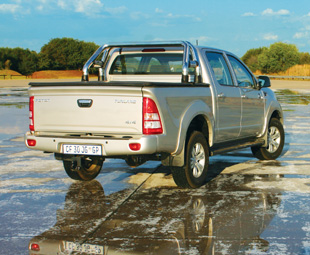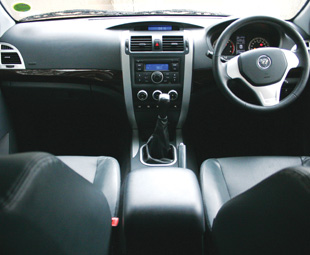A nice surprise

Chinese vehicles amaze in one of two ways. Either the vehicle is disastrous, or, as GAVIN MYERS discovers with the Foton Tunland, it’s a truly brilliant surprise.
Oh yes, the Chinese are coming. I know it’s been said for quite a few years now, but Foton, with its new Tunland double cab, is proving the seriousness of that intent. Now, before you laugh and say “it’s just another cheap collection of flimsy mismatched parts, poorly thrown together”, read though the details …
According to Foton, the Tunland is the result of one of the most comprehensive and thorough research and development programmes ever undertaken by the company. This included the expertise of Chinese, Japanese, European and American engineers as well as the use of over 30 international component suppliers. Namedropping includes the likes of Cummins, Bosch, Continental, ZF, Dana, Getrag and Borg-Warner. And the results do speak for themselves.
During our time with the Tunland, its bold presence attracted a lot more attention than we anticipated. People really do look at this vehicle and are genuinely interested in what it is (and, once they know what it is, how good it is).
 With bold lines and generous splashes of chrome, it would seem then that Foton has certainly got the styling right. Thanks to the large grille and front airdam the front-end certainly has presence, though some found it a little gawky from certain angles. Refreshingly for a bakkie, the load bay is interestingly styled; with its strong crease lines on the sides leading to what could almost be mistaken for a spoiler … It is really just a styling lip around the upper edge of the load bay.
With bold lines and generous splashes of chrome, it would seem then that Foton has certainly got the styling right. Thanks to the large grille and front airdam the front-end certainly has presence, though some found it a little gawky from certain angles. Refreshingly for a bakkie, the load bay is interestingly styled; with its strong crease lines on the sides leading to what could almost be mistaken for a spoiler … It is really just a styling lip around the upper edge of the load bay.
The interior is just about as well-executed as the exterior. Interiors of Chinese vehicles are usually where the ball is dropped. The design is generally fine, however, the quality of materials and overall fit and finish – the tactile aspects – are what lets them down. The Tunland makes an impressive effort of it, though.
Available in two spec levels of Comfort and Luxury, the Tunland’s interior is roomy and very neatly designed. Most of the plastics used do not feel cheap, but there are a few areas, such as the “wood grain” trim and lower centre consol, that could be better. All controls and hidey-holes fall neatly to hand and, importantly, the controls and switchgear have a quality feel to their operation. Fit and finish is good, everything fits properly and is well put-together – there was not a single rattle or squeak from the Tunland’s cabin, giving a good impression of solidity.
Our main concern was of the “leather” on our Luxury-spec model – this did feel cheap and could definitely benefit from a more upmarket feel. That said, the seats themselves are fairly comfortable, if a little hard. The rear bench offers particularly good comfort.
Feature-wise, Foton has equipped the Tunland well with: air-conditioning; a sound system with USB and auxiliary connectivity; remote central locking with remote window closing; onboard fuel consumption and range readouts; front and rear fog lights; and daytime running lights in the mix.
 The Luxury-spec vehicle benefits from niceties such as: a one-touch driver’s window; anti-pinch function on all windows; a four-speaker audio system (yes, the comfort models only have two speakers!); and park-distance control (the audible beep is, however, too soft). There are some expected features that the Tunland is missing, though, such as remote audio controls and an outside temperature readout, for example.
The Luxury-spec vehicle benefits from niceties such as: a one-touch driver’s window; anti-pinch function on all windows; a four-speaker audio system (yes, the comfort models only have two speakers!); and park-distance control (the audible beep is, however, too soft). There are some expected features that the Tunland is missing, though, such as remote audio controls and an outside temperature readout, for example.
Safety features include ABS with EBD, dual front airbags and seatbelt pre-tensioners.
It’s a case of so far so good then, but how is it to drive? Well, you would have doubtless seen the “Cummins 2.8” badges adorning the side of the vehicle. That’s right, there’s Cummins firepower under the bonnet. The 2,8-litre, four-cylinder ISF engine develops 120 kW at around 3 500 r/min and 360 Nm torque between 1 800 and 3 000 r/min. The torque band is quite short and the oomph drops off fairly rapidly once you’re past the power peak – the engine does not feel as powerful as the figures suggest, but as long as the turbo is kept singing it does keep pulling.
The powertrain is rated at Euro-4 emissions level, and produces 219 g/km of CO2. Foton does not supply any fuel consumption figures, but the onboard consumption readout displayed a good 9,3 l/100 km at the end of our time with the car.
The gearbox, a Getrag unit, felt solid but notchy. An unexpected and unnerving problem reared its head a few times in heavy traffic, when the clutch began to overheat. This was, however, the only mechanical problem experienced. The 4×4 models benefit from electronic on-the-fly selection between two- and four-wheel drive, but there is no option of a diff-lock.
Ride comfort is good, however it is softer than one would expect of a bakkie. This does make us wonder how it will cope with a full load on the back. In terms of payload, the 4×4 models are rated at 965 kg with a 2 975 GVM, and towing capacity is 2 500 kg.
Another area usually of concern with Chinese vehicles is the aftersales back-up. Foton has addressed this by offering a three-year/100 000 km warranty, three-year roadside assistance within South Africa, a two-year/40 000 km service plan, and a three-year/unlimited kilometre anti-corrosion warranty. Current pricing for the 4×4 Luxury model we had on test is a very reasonable R359 950.
The Foton Tunland is easily the best Chinese vehicle we have yet driven. It’s well put together, using mostly good materials, offers a good amount of kit and is nice to drive. Our main concern comes in with the overheating clutch – something the manufacturer needs to address. Of course, this could have been a problem particular to our vehicle. We sincerely hope it was, because the Tunland has everything required to enjoy the success it should.
Published by
Focus on Transport
focusmagsa




